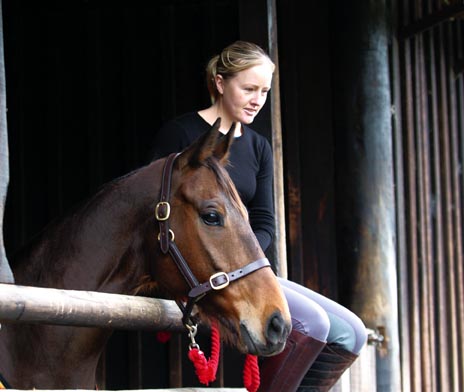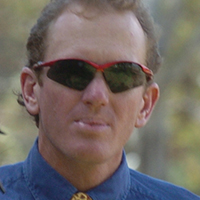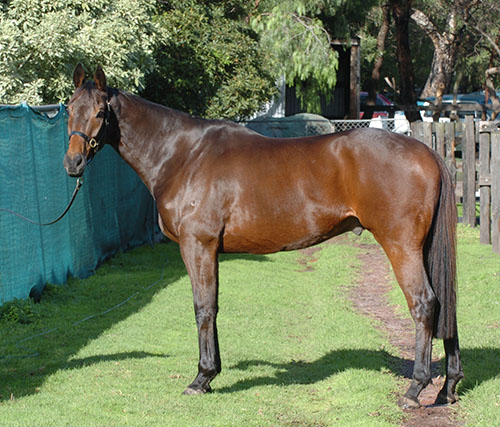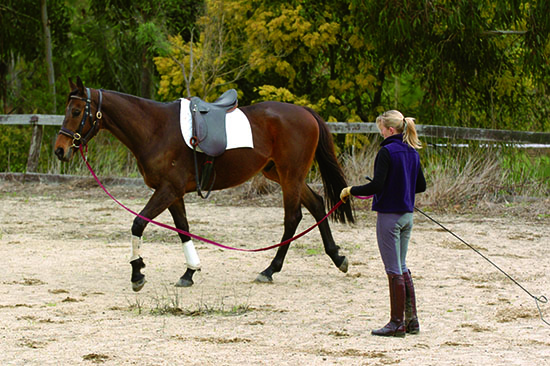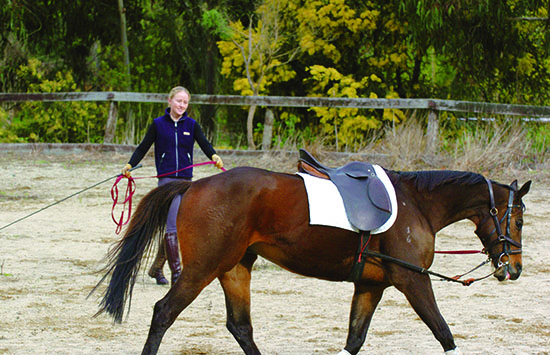As explained last month, Rupert has been part of our life as a racehorse for the past five years, so we didn’t go through the normal process of selection. Since most riders involved in the racehorse re-education process will actually have to select their prospect off the track, we asked one of Australia’s most respected performance horse trainers, Craig Barrett, what you should look for – and what you should avoid. He was pleasantly enthusiastic about our boy:
“If I’m buying a horse off the track, this looks like a sensational horse, he’s gorgeous, he’s got a lovely head, he’s got a lovely expression with a very kind eye. You can never tell temperament from a photo, but he looks nice and calm.”
“The fact that he has been a good horse on the racetrack tells me that he is a good horse. A good horse is a good horse, and a sensible horse is a sensible horse. If he was that good on the track, and the trainer says he was quiet, that is just about guaranteed to train through.”
“His conformation for me is just a classic Thoroughbred – sensational for eventing. He’s got a lovely neck, his neck comes out of his wither, his wither is higher than his rump – or that is how it looks in this photo. The quarters are really well developed, evenly developed by the look of it. He has a straight line from the point of his fetlock, up through his hock to the point of his rump.”
“He is not overly bent in the hocks, which is good for a jumper and a galloper. There are no excessive angles, they are all quite straight – his pastern to his hoof on the back, and on the front, are all good. I can’t really see his joints properly, but they look OK.”
If someone says ‘but he is a wind-sucker’, do you walk away?
“For a performance horse no – but if you are buying the horse to sell on, then walk away because you will have trouble selling a wind-sucker. For a competition horse I don’t worry – especially when you look at the condition he is in. I’ve had wind-suckers, and some of them, have been really good horses. Wind-suckers aren’t an issue for me. You don’t like looking at them sucking on the stable door, but certainly a collar fixes a lot of that.”
When you get a horse off the track, do you bush it, or does it go straight into work?
“An eight year old like that you would work straight away. His condition is very conducive to being worked straight away – he is strong in every area of his conformation, he is not going to struggle with being worked on the flat, or over jumps. A little bit would depend on his attitude – if he is looking stressed, if he is looking worn out, he doesn’t come up for his feed, if he stands in the corner of his box with his head down – then he may need a break. It would depend on his state of mind.”
“If they are fresh, happy and alert, I am quite happy to work them straight away. I’m not going to drill them; they can have half an hour. All my horses live out – so I don’t have a problem with horses getting cranky in stables, but if a horse did come that was cranky, trying to bite and kick, then yes, maybe it’s time to turn it out.”
“The first lot of work we do with a Thoroughbred is getting the horse going in a straight line. Classic racehorses, they want to go too fast – and I think the quickest way we can take that out of them, is to do your flat work, maybe on one circle, or two circles, where you don’t give them a lot to think about, and you do try to let them wind down. You don’t try to teach them to stay really slow straight away; a lot of them don’t like that. You actually have to let them stay very forward until they start to relax, then you can slow them down.”
“Straight lines and on a circle, a lot of them will drop in one way, and I feel you have to wait until they are going straight and a little relaxed before you can put your inside leg on and teach them to stay away from the inside leg and all that business. Relaxing, not wanting to run away taking the bit. I like to get them to go walk, trot and canter on a loose rein, now they still might be dropping in but if they are going on a loose rein they are starting to relax, as long as they are not grabbing the bit.”
Alas for us, we were not able to follow Craig’s advice, thanks to a combination of the wet weather hitting Upper Pakenham in a big way, and Vanda being heavily involved in her uni course. So Rupert had his spell, and when the arena dried out enough to work on it, some gentle lunging to introduce him to the new way of going.
Roz and I have always been great fans of the lunging line – it is a way of shaping a horse where you are 100% concentrated on the horse, you don’t have the distraction of having to worry about your position, and he doesn’t have to work out what the person on his back is doing. We feel that until the horse will happily give his back and go deep and round and loose, there is not much point in putting a rider on his back – especially as the very fact that a rider is on his back is likely to encourage him to go upside down.
As you can see, Rupe was very upside down. Roz lunged him in the loosest of side reins at first, and then gradually tightened them so he would not hit the bit and give himself a fright. Once he was comfortable in the side reins, she switched to running side reins, a gentle gimmick, that encourages the horse to lower his neck and raise his back. Of course the crucial factor in all of this is that the horse must be going forward all the time. Tying them up in a stable just teaches them to back off and drop the bit and will cause serious problems further down the track.
Rupert took quite some time on the lunge before he even thought about letting go, he would put his head down for a quarter of a circle, then back up in the air in chook position, then investigate the chances of going low again, up again, that’s horses. The important thing is not to try and force the issue, just keep quietly poking along until he works out how much more comfortable it is with his neck down low and his body free and swinging. Roz worked him at first for just ten minutes, because this sort of work is quite hard, building up to twenty minutes, and making sure she equally divided the time to the left and the time to the right – but only after he was comfortably going forward on the lunge. At first, it is better to work them just one way until they really get the idea without confusing them by asking them to go the other way.
After looking at him work in the running side reins, we felt that he was still feeling a bit restricted even when he went low, so we switched back to the ordinary side reins, and he seemed much more comfortable when he did go low, and more likely to stay there, so we gave up on the running side reins and just stuck with the ordinary old side reins.
Hopefully in a month or two, when Vanda has finished her studies for the year, he will be ready to go into some serious work…
Feeding the ex-racehorse – with Liz Owens
Ever since he came home, Rupert had been eating a low energy pellet, with some lucerne chaff and plenty of hay. There is not much of a pick in the little paddock he lives in…
It was time to get some advice from one of my favourite people, equine nutritionist, Liz Owens. Liz has a refreshingly no nonsense approach to the subject of feeding, and she is not afraid to give you the first degree to work out exactly the right recipe…
What does he look like?
“He is still a bit skinny and racehorsey, and he has just started doing 15 minutes lunging a day to try and re-arrange his upside down muscles. Am I feeding him the right diet?”
Over to Liz:
“The trick often with ex-racehorses, is to find out what the trainer was feeding them. The trainer will tell you one thing and often feed them quite differently. It helps if you know the trainer and they are honest and open, that makes it easier… Then if they say, the horse hasn’t been turned into a pin cushion, you can pretty much believe them. If a horse has been treated with steroids or hormones, that can make your task that much harder because there will be a period of time when those things are wearing off, when they just look diabolical no matter what you do.”
“The other thing that is important is to observe how much hay the trainer feeds his horses. In Australian stables the tradition unfortunately is to feed a lot less hay than is good for them. If you go into racing stables in Kentucky or in the UK, the first thing you will notice is a thumping great hay net full of grassy hay, that is there 24 hours a day for the horses to chew on. You don’t see that very often in Australian stables, and the result of that is our horses tend to be not as good at digesting fibre because they have never done it to any great extent. That’s why it tends to be a disaster when people get their horse home from the track – loaded up with steroids – and they toss him out in a paddock to live on fibre and cellulose, and this is an animal that has never had to survive on fibre and cellulose. Every other horse in the paddock gets as fat as butter, and your dear Thoroughbred is looking like a hat rack. In most cases you have to wean them off what they are currently getting, and start to introduce them to hay in their diet over a period of weeks and months, until you have established how well they can cope with it, before you can really ‘rough’ them off in the way you might like. That might not be the case with your horse, but it is a common problem that I get, people forget about making diet changes gradually and just throw them out into the paddock, poor darlings.”
Is your horse hot or is he being rational?
“He’s warm.”
“Probably one of the safest ways to put weight on any horse is with good quality roughage. Because he is eight you don’t want to go mad with lucerne hay or anything like that, they don’t need that level of protein but if you have got good grassy hay, that is ideal. Rye grass / clover combination, or oaten hay is grand. They can have hay in front of them 24 hours a day, especially if they are not on good pasture. Good hay and as much as he can take.
Then something like the CalmPerformer pellets, that we make, a low starch, low energy pellet is very good until you get them under the thumb, which seems to be the stage you are getting to now.”
“The other low starch energy source you can add is oil, and you can do that with the EquiJewel product from KER – that is very good because it is so palatable. You feed about a kilo a day, and the advantage of that is that it is going to give you some vitamin E and selenium to help prevent muscle damage. Start off at 500 grams a day – a kilo a day is the top level you need to go to.”
Are ulcers a worry thing at that stage?
“90% of Thoroughbreds will probably have ulcers, but if he has been out on a spell and he is eating plenty of roughage, then it shouldn’t be too much of a problem. The only way to know what damage has been done is to scope him and see what evidence there has been of ulcers in the past. It’s pretty expensive to put him on an ulcer treatment just on the off chance that he might have them. I would assume that he has had ulcers but we need to see if he is feeding on hay and pasture regularly and he is eating his feed normally. A horse with ulcers will start to eat, walk away and look unhappy, and a bit colicky, then that will pass and they will come back and eat again. If you observe him eating and if he is standing over his feed bin, and finishing up hay nets, then you can assume he is over the ulcers.”
He is certainly not finishing up his hay nets…
“Have you weighed the hay to see how much he is getting.”?
Liz, I am an Aussie, you know we don’t weigh feed…
“It’s like how much molasses do you feed. Two globs. It’s an Australian international measurement, the glob. You should weigh the hay, and at about 16.2 hand with no access to pasture, he should be eating about five or six kilos of hay a day. If he is eating significantly less than that, you have a problem, he is not eating enough roughage.”
“The only thing I would change at this stage would be the Equi Jewel, in conjunction with Calm Performer, and because that has got the Vitamin E and the selenium, then while you are trying to change his shape from a skinny banana to an upside down banana, he is going to be having some sort of muscle pain associated with that – depending on how tight you tie the chambon…”
The loosest of side reins, I swear!
“Still a bit of Vitamin E can be a help…”
Liz’s advice was mirrored by the other Australian feed manufacturers. That’s one of the nice things about the today’s market, there is such a wide variety of feed formulations, that it is literally possible to find a pre-mixed feed for every need.



